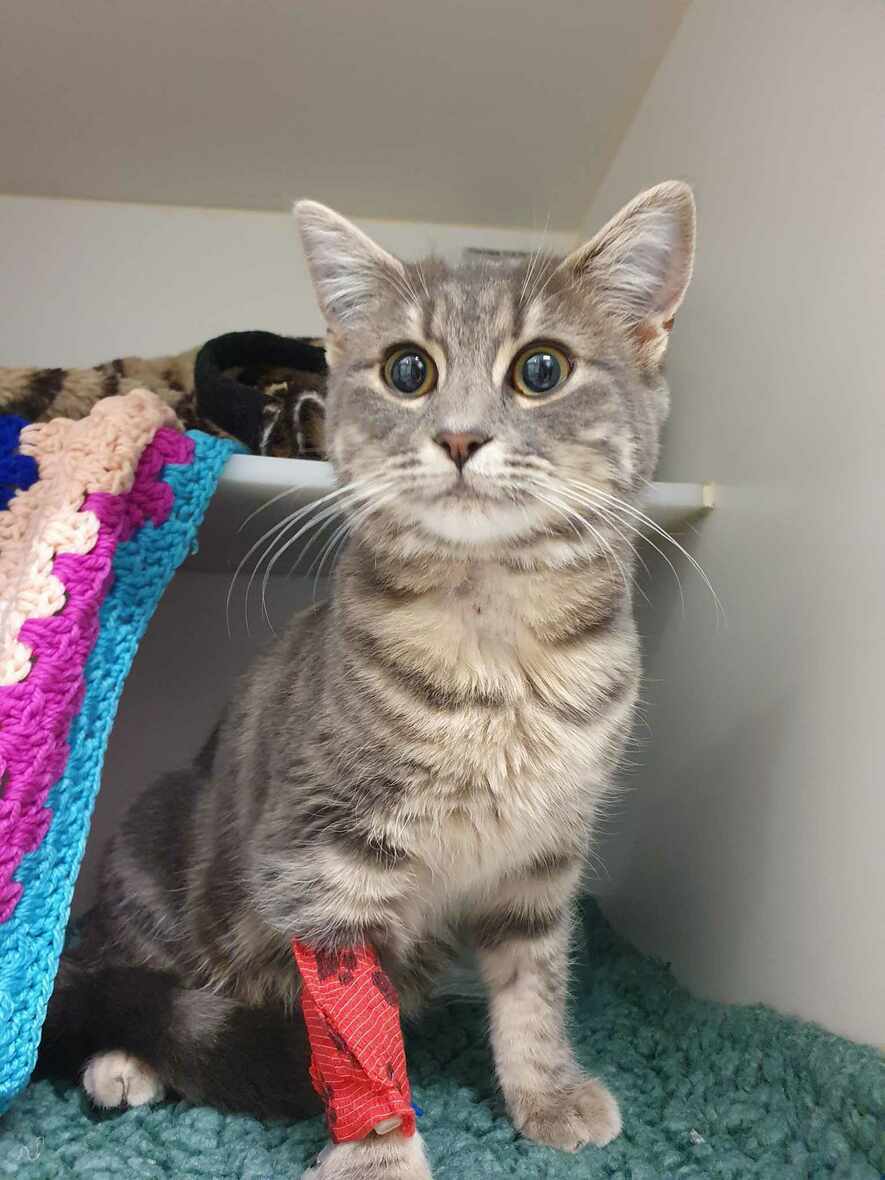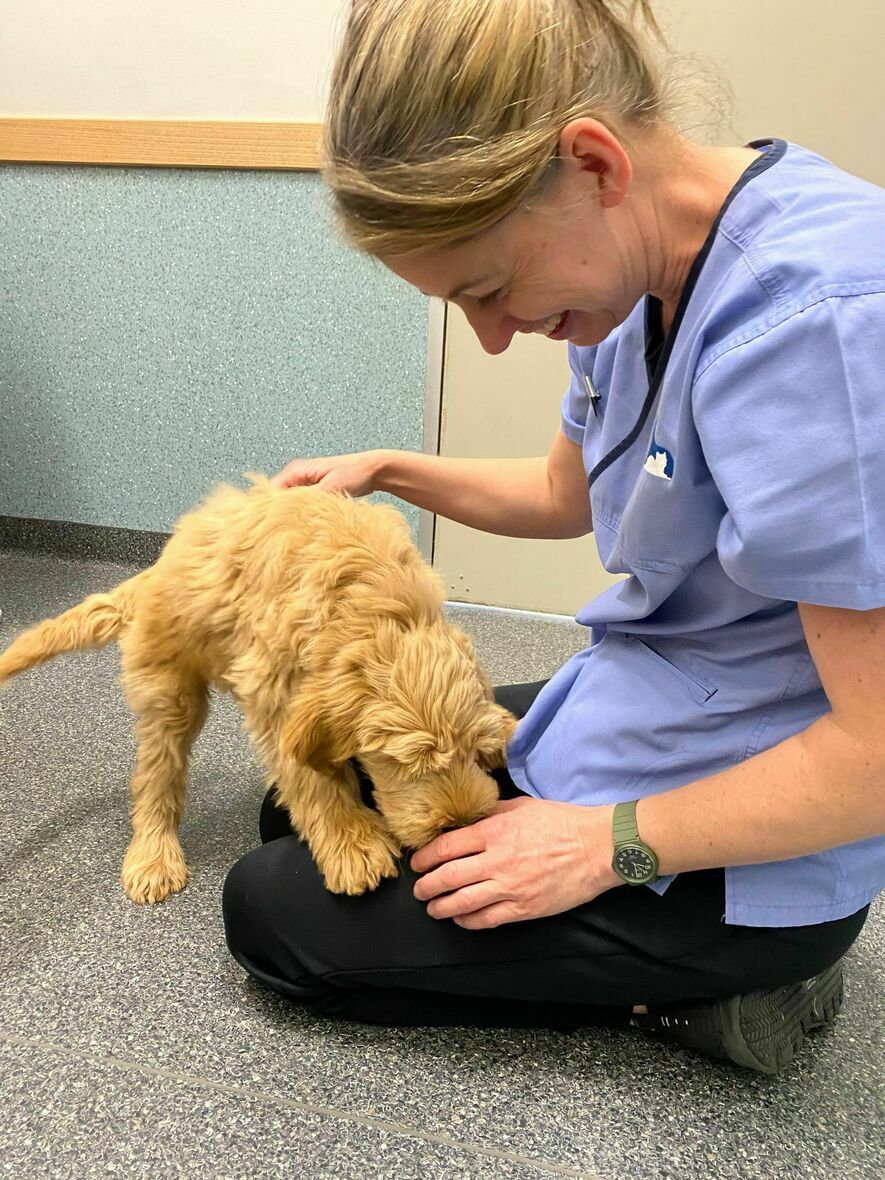 | | Snake bites in our pets | | | Spring is well and truly here and summer is just around the corner. As our weather heats up we are already seeing an increase in snake sightings and in turn, unfortunately, snake bites. There are a large number of dangerous snakes in our state, but the two that our pets are most likely to come across in the Gawler area are Brown snakes and Red-bellied Black snakes, with Brown snakes the far more common of the two. Our dogs and cats are naturally curious, and this unfortunately can lead to altercations with snakes, and in some cases they can be bitten.
What to do if you find your pet with a snake:
If you happen to find your pet in the same area as a snake, whether the snake is alive or dead, it is always safer to assume they have been bitten and act accordingly. It’s important to remember that, although we all love our pets and would do anything for them, that your safety is of the utmost importance so never put yourself in danger.
Never attempt to catch or kill the snake, but if it is safe to do so make note of the type or take a photo as this can assist with treating your pet.
Cats and dogs respond quite differently to snake bites, with dogs generally succumbing much quicker. Snake bites earlier in the season tend to be more severe than those late in summer, as the snakes venom glands are fuller from a quiet winter.
Dogs
Clinical signs of a snake bite can differ between dogs, the snake species and the amount of venom injected. Usually the most common signs are generalised weakness and/or collapse sometimes followed by a temporary period of recovery, twitching of the muscles, vomiting, dilated pupils, loss of bladder/bowel control and after more time has passed paralysis.
If you are at all suspicious that your dog may have been bitten by a snake, the best thing to do is head to your nearest vet clinic and phone them on they way to let them know you are coming. If your dog is not showing any clinical signs then it is often advised that they stay at the clinic for an hour or so, whether that be in the hospital area or just in the waiting room with you, so that if they start showing signs we can start treatment as soon as possible.
Cats
Cats can be a bit trickier with snake bites and it can sometimes take hours or even days for them to show clinical signs. The most common signs we see in our cats are weakness and incoordination that progresses to lethargy and floppy paralysis.
If you notice any suspicious signs in your cat, calling your local vet clinic and getting them there quickly is the best thing you can do. Due to the variability in onset time of clinical signs, we don’t often monitor cats in hospital waiting for clinical signs.
Brown snake venom works by causing both paralysis and uncontrolled bleeding. Once in our team’s hands, we can diagnose a snake bite in dogs with a blood test that assesses blood clotting times. There is not a reliable blood test in cats so diagnosis is generally based on clinical signs. If we suspect your animal has been bitten, we can start treating them with snake anti-venom and supportive care. Sadly not all snakebite pets survive, even with anti-venom, but our chances of success are much greater with quick action.
If you have any suspicions when it comes to your pet and snakebites, give our team a call and we can help guide you with the best options in a stressful time. |
|
|
 | | 4 tips for moving with pets | | | Are you planning on moving house with your pet? Read on for our top four recommendations to keep your pet safe and ease everyone's stress!
1. Keep your pet's microchip details up to date
As soon as you move, updating your contact and address information on the online database that lists your pet's microchip number is essential.
The database details will be available on your pet's original microchip paperwork, but if you need clarification, contact our team for help or try searching your pet's microchip number on Pet Address.
2. Safety in style: collars and tags
Whilst microchips will allow vets and other authorised identifiers to scan your pet and search your contact details, it's a good idea also to ensure that your pet is wearing a well-fitted collar and tag bearing an up-to-date contact number (such as your mobile number).
These measures will help your pet reunite with you more quickly should they be found by a member of the public, especially outside of regular veterinary clinic hours.
3. Ensure your pet is safe on a moving day
It can be pretty easy for pets to escape and become lost on a moving day, given that people will be traipsing in and out of your property, and doors may be left open.
It is often easiest to book your pet in for overnight boarding on a moving day, but if this is not possible, ensure that your pet is otherwise safely confined in a well-ventilated room or crate, with access to water and regular opportunities to toilet.
4. Reduce pet anxiety
The hustle and bustle of packing and moving can be unsettling for pets, and they may pick up on your stress, too!
If you think your pet will likely become significantly anxious, consult our vets about safe options for temporary anxiety relief supplements or medications. With some good preparation, you and your pet can happily settle into your new home in no time! |
|
|
 | | Pediatric parasites | | | Unfortunately, your new canine or feline friend could arrive as a package deal with a few “friends” of their own!
Internal and external parasites in puppies and kittens are reasonably common. They are usually due to infection passed from the mother.
Here’s what to monitor your new family member for.
Intestinal worms
The four most common intestinal worms in dogs and cats are roundworm, hookworm, whipworm, and tapeworm.
Roundworms may cause diarrhoea, a pot-bellied appearance, or a failure to gain a healthy weight. They may occasionally be vomited up or defecated out from heavily infected pets.
Hookworms feed by latching onto the intestinal walls of infected animals and drinking their blood. As a result, they can cause blood loss anaemia, leading to symptoms such as weakness and pale gums.
Whipworms live in the large intestine, sucking blood and causing inflammation, sometimes leading to recurrent gooey or bloody diarrhoea and occasionally generalised weakness.
Tapeworms absorb nutrients from the small intestine, generally causing little harm unless in large numbers. The egg sacs they release (which look like wriggling rice grains!) may irritate the pet’s bottom.
Fleas
Adult fleas live on the skin, sucking the pet’s blood and laying eggs shed around the pet’s environment.
Young puppies or kittens with large fleas may develop blood loss anaemia. Fleas can also cause significant skin irritation, leading to bacterial skin infections in some pets.
Ear mites
Ear mites live within the ear canal of puppies and kittens, causing localised inflammation.
Pets with mite infections develop irritated ears (which may cause them to shake their heads or paw at their ears), and their ears canals may look red and inflamed with dark brown discharge.
Young animals can be especially vulnerable, so if you notice any symptoms of unwellness in your puppy or kitten, have them checked promptly by our experienced team. We’ll banish any pesky parasites pronto! |
|
|
 | | Giving fleas and ticks the flick | | | A lot has changed in parasite prevention since the old days of dousing your pet's fur with a strong-smelling spray every couple of weeks or administering a daily tablet!
Here's how to keep fleas and ticks away from your cat or dog quickly and effectively and why it's a good idea.
Flea infestation
As the most common external parasite in dogs and cats, fleas are more than just an irritation.
A flea infestation can lead to:
- Severe skin inflammation in pets who are allergic to flea saliva
- Secondary bacterial skin infections
- Anaemia (low red blood cell levels) in very young or old pets
- Large numbers of flea eggs in the home environment, which can be difficult to eradicate
Tick-related disease
In certain regions, brown dog ticks can potentially transmit infectious severe diseases to the pets they bite, such as ehrlichiosis in dogs.
The toxin naturally released by paralysis ticks also causes paralysis in affected pets, leading to symptoms such as:
- Progressive leg and body weakness
- Breathing difficulties, which can prove fatal
- An inability to blink or toilet normally
How can pets be protected against fleas and ticks?
It's best to keep your pet protected against fleas and ticks all year round if it goes outdoors (or shares a space with another pet who goes outdoors). Whilst ticks are less active over winter, they can still be present in the environment, and fleas can survive all year round in warm homes.
For flea and tick prevention in dogs, you can administer monthly or quarterly tasty chewable tablets; for cats and dogs, you can apply topical drops or veterinary-strength repellent collars.
We're the anti-parasite professionals for keeping creepy crawlies away from your pet, so consult our team for personalised advice on your pet's safest, easiest, and most effective parasite protection options. |
|
|
 | | Animal News In Brief | | | This household is full to pussy's bow with 70+ cats
Karen Smy and her daughter Lauren Sheldrick run a small-scale rescue operation, 'Karen's Cat Community'.
The demand for rehoming cats in the UK is booming. "We've always been a multi-cat family,” said Ms Smy. Roughly 60 of the cats are rescues, and Karen and Lauren have cats on their own, totalling more than 70 cats in their care.
Ms Smy believes the driving factor behind the increase in rescues is a combination of owners' failure to spay and neuter their cats, leading to unexpected litters of kittens, and people who adopted pets during the pandemic realising they can't afford to care for them.
Despite the challenges, the immense workload, and hefty costs - 135 pounds a day on cat food and litter alone! Karen and Lauren enjoy caring for the cats and have a deep bond with the animals. They hope to find homes for all their rescued animals by the end of October, using platforms like TikTok to connect with fellow cat lovers and raise awareness for their cause.
Click here to read the BBC's article on Karen, Lauren and the 70+ cats.
Chloe that cat found interstate after three years MIA
After a three-year search, a cat that went missing in Victoria has been found across the border in New South Wales, about 12 km from where she disappeared.
Chloe, a white domestic shorthair cat, went missing from her home in north-west Victoria in 2020 while her owners were on a trip to Melbourne. “We put up flyers,” said Chloe’s owner, Hayley Dale, “I posted all over social media looking for her, and there was just nothing. After about two years, we [marked] her as deceased because she had never come home and no one had ever contacted us.”
It may have seemed like all was lost, but when a vet (who happened to know the Dale family) across the border in New South Wales recognised Chloe and alerted the Dales, they were delighted. “We thought it must have been a mistake because she had been gone for so long. We couldn’t believe it.” Ms Dale said.
Click here to read the ABC's article about Chloe the cat.
LifeView leads the way: aged care residents allowed to keep pets
Few aged care homes in Australia currently allow residents to bring their pets. While evidence shows that pets can improve older people's mental and physical well-being, concerns about hygiene and resident frailty risks (such as tripping or stumbling over animals) often prevent facilities from permitting pets.
As the number of aged care residents grows, pet-friendly facilities are expected to become more important for elderly individuals and their well-being. While services such as Christian Homes Tasmania do not allow pets, it encourages pet therapy visits from local animals and their carers, providing emotional benefits to its residents.
However, one group of aged care homes in Victoria is leading the way to a friendlier, furrier future for elderly Australians. Lifeview Aged Care allows pets and encourages residents to bring them as long as they can care for them. "They're giving up a lot to move into care," said Lifeview CEO Samantha Jewell, "So this is just one less thing that people have to give up.”
Watch the ABC's coverage of this story here. |
|
|
 | | Vaccination through the years | | | Whether your pet is a baby or a fully grown canine or feline friend, staying updated with their vaccination schedule is essential. Here’s the situation regarding vaccination!
What vaccinations should my pet receive?
Your pet must stay current with at least their core vaccinations – these are common infectious diseases worldwide that can potentially cause severe unwellness or even death.
For cats, the core vaccinations comprise the F3 vaccine, which protects against feline panleukopenia and two common causes of cat flu (feline herpesvirus and calicivirus).
In dogs, the core vaccinations make up the C3 vaccine, which protects against canine parvovirus, infectious hepatitis, and distemper.
Additional non-core vaccinations in both species are recommended case-by-case, depending on your pet’s lifestyle and the areas they visit. These include the kennel cough and leptospirosis vaccines in dogs and the chlamydia and feline leukaemia virus vaccines in cats.
How often should my pet be vaccinated?
Most vets will recommend kittens and puppies receive three sets of vaccinations: at 6-8 weeks old, 10-12 weeks old, and 16-18 weeks old. Depending on your pet’s particular risk factors, we may recommend they receive an additional vaccination at six months.
After that, your pet will require vaccination every 1-3 years to stay up to date with their vaccinations, depending on the vaccines in use.
What should I do if my pet has become overdue for vaccination?
Should your puppy or kitten miss a vaccination during their initial triple vaccine series, they may need two additional vaccinations to achieve a sufficient immune response.
If your adult pet is overdue for vaccination, it’s best to chat with our veterinarians. Their recommendation will depend on your pet’s particular prior vaccination history. |
|
|
 | | #NoSpraySeptember to protect beneficial bugs | | | Spring is here, and with the warmer weather, flowers, and pollen comes an increase in insect activity in our gardens. Like many Australians, if you see a gnat, a fly or an insidious mosquito, you might be tempted to reach for the bug spray.
Invertebrates Australia advises against broad-spectrum insecticides, AKA bug spray, due to the unintended harm they can do to non-target species. Gardens are home to many beneficial insects, such as ladybugs and bees, that naturally pollinate and control pest species. But insecticides persist in the environment and can have long-lasting effects on these helpful critters, garden soil, waterways and even the human food chain.
Invertebrates Australia is promoting 'No Spray September' as an initiative for sustainable pest management. How can you join the cause? Ensure your fly wire is correctly fitted, in good condition and free of holes. Attract beneficial insects to your garden to help naturally control pests by planting diverse flowers, herbs and native plants. It doesn't hurt to share your beautiful garden pics alongside the hashtag #NoSpraySeptember, too!
View the ABC's original broadcast here |
|
|
 | | Check out this proactive healthcare! | | | Your pet isn't showing any signs of unwellness. Therefore, they won't benefit from a veterinary check-up: true or false?
It's false!
Even if your pet seems to be doing OK, a general check-up every 6-12 months is strongly recommended to keep them feeling their best throughout their lifetime. Here's why.
Hidden illnesses
Not every illness will cause overt signs of unwellness, at least in the early stages. Some diseases can have a more insidious onset, causing little to no outward symptoms until things are advanced. Unfortunately, in some cases, when the pet shows clear signs of an issue, the options for treatment or management may be more limited.
Common "hidden" health issues in pets include:
- Tissue masses that appear like "fatty lumps" or "warts" but are a more concerning type of tumour.
- High blood pressure in pets, which, if severe, can cause sudden, irreversible blindness and damage to the heart and kidneys.
- Mitral valve disease, a type of progressive heart disease, can be managed more effectively if detected before it starts to cause overt symptoms.
Proactive healthcare and routine maintenance
Even if your pet is generally well, a regular check-up allows us to perform a complete physical examination to check your pet's weight, mobility, and general condition. We will also assess for any developing issues, such as dental disease, as regular preventative dental cleans cost far less than the extractions required for advanced dental disease (and are more comfortable for the pet, too).
For older pets, we will also discuss the option of general blood and urine tests, which can help screen your pet for any early-stage organ problems, such as liver or kidney disease.
So, even if your pet seems in good health, book them in for regular check-ups so we can help keep them feeling their best! |
|
|
This email contains comments of a general nature only and is not intended to be a substitute for professional veterinary advice. It should not be relied on as the basis for whether you do or don't do anything.
All content © PetPack 2023 |
|
|
This email was sent to:
email@example.com
Gawler Animal Hospital
76 Adelaide Rd
Gawler South, SA 5118
|
|
|
|